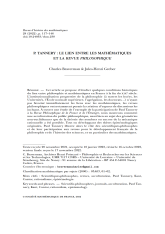P. Tannery : le lien entre les mathématiques et la $Revue$ $Philosophique$
P. Tannery: the link between mathematics and the $Revue$ $Philosophique$

- Consulter un extrait
- Année : 2022
- Fascicule : 2
- Tome : 28
- Format : Papier
- Langue de l'ouvrage :
Français - Class. Math. : 03A03, 01--02
- Pages : 117-146
- DOI : 10.24033/rhm.238
Cet article se propose d’étudier quelques conditions historiques du lien entre philosophie et mathématiques en France à la fin du XIXe siècle. L’institutionnalisation progressive de la philosophie (à travers les lycées, les Universités, l’École normale supérieure, l’agrégation, les doctorats n’ayant pas favorisé immédiatement les liens avec les mathématiques, les revues philosophiques ont notamment permis la création d’espaces de discussions les incluant. À travers une étude de l’exemple de la participation de Paul Tannery à la Revue Philosophique de la France et de l’Étranger, nous montrons comment une acculturation du public philosophique, aussi bien au sujet des géométries non-euclidiennes que de la théorie des nombres ou encore de la mécanique rationnelle a été possible. Tout en développant des thèses épistémologiques originales, Paul Tannery illustre alors le rôle des scientifiques-philosophes et de leur participation aux revues pour le développement français de la philosophie et de l’histoire des sciences, et en particulier des mathématiques.

